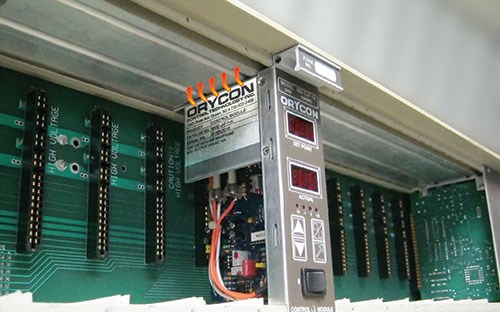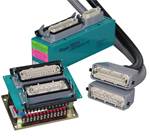Gain Process Control with a Specialized Hot Runner Temperature Controller
Hot runner systems present unique thermal situations that require specialized temperature control for manifolds and nozzles.
Typically, a hot runner system refers to the heated manifold and nozzles that go into a mold; in reality, the controller, once it is coupled with the mold, also becomes an integral part of the system. When it comes to successful mold operation, the controller’s performance is just as critical a factor as the mold components’ performance.
Accurate and responsive temperature control is essential, as the best manifold system in the world is not going to do the job all by itself, and obviously a great controller without a good manifold system is not going to be of much use.
Consider specialized temperature controllers for manifolds and nozzles because of the very unique thermal siutation a hot runner system presents. For example, the manifold needs to be kept at fairly elevated temperatures, while the mold with which it is in contact needs to be cooled. General-purpose controllers, which may be adequate to control the temperature of a press barrel, are not going to work well in the dynamic environment of a hot runner system.
In order to control both sides (heating and cooling) and optimize the entire system’s performance, there is great value in finding suppliers who manufacture both controllers and manifold systems.
The Controller Breakdown
Hot runner controllers that are model-predictive and not pro-portional-integral-derivative (PID) allow users to zero in on the requirements of the hot runner system more readily, and without the trial and error of the conventional PID routine. The difference is that PID responds to parameters that are preset by the manufacturer and, in certain situations, by the user, based on expected zone conditions. However, conditions within the same hot runner system may differ substantially from one point to another.
For instance, a manifold zone and a nozzle zone will behave completely different from one another, and if the same control parameters are used for both, the result is going to be less than desirable in one or the other. If one tries to make a universal PID setting, the result may be a compromise in performance for both zones.
By contrast, model-predictive controllers sample the zone for current load (watts), response time and the rate of temperature rise, in addition to other conditions, and then use an algorithm to predict how and when to apply power in order to get the required results. Also, adjustment to the control parameters is constantly occurring during operation to compensate for factors such as changes in set-point or mold temperature. With tight gate vestige requirements and demanding engineering materials becoming more and more common, model-predictive controllers can help solve many processing problems.
Keeping it Clean and Cool
For the continued accuracy of any controller, it is very important to keep the circuitry clean and properly cooled. This may prove difficult to achieve on an injection molding shop floor. Even in shops where the product is food-related and everyone wears hair nets, dust and other contaminants can accumulate on the internal electronic components of hot runner controller cabinets.
Thick layers of dust and sometimes even cobwebs can be found in most controllers that use circulating fans to cool the circuits. Dust, tiny plastic particles, lint and a variety of mist types can be drawn into the controllers by the fans and trapped by the electronic components that protrude from the boards inside. Once these particles stick to the components, they create a textured surface that makes it easier for more particles to get trapped and accumulate, forming insulating layers over the components.
Semiconductors and other components are affected by temperature, and circuit performance under a blanket of dust is not the same as in free air. For this reason, higher-accuracy models use static cooling rather than fans. Heat sinks are employed as an integral part of the controller housing (or mainframe), and since there is no air circulating internally to carry contaminants, the electronic components are kept clean and at peak efficiency.
It is critical to establish a maintenance program that includes vacuuming the internal surfaces of all controllers that use fans. The schedule may vary according to the degree of free-floating dust in the shop, however, if at some point the dust is not removed, accuracy will be affected, and eventually units may fail altogether.
The static cooling type of controller can be cleaned by simply wiping off any visible dust from the cabinet’s external heat sink. The units are designed to keep potential contaminants away from sensitive areas, so circuit performance is not affected and the “other half” of your hot runner system keeps working at peak performance for much longer.
Related Content
Fundamentals of Designing the Optimal Cooling System
The right mold components can help improve mold cooling and thereby produce higher-quality parts.
Read MoreForces and Calculations Are Key to Sizing Core Pull Hydraulic Cylinders
To select the correct cylinder, consider both set and pull stroke positions and then calculate forces.
Read MoreAdvantages and Disadvantages of Copper and Graphite Electrodes
Both copper and graphite provide approximately the same end result, so it is important for a shop to consider the advantages and disadvantages of each material in order to discover what would work best in their shop floor environment.
Read MoreSolving Mold Alignment Problems with the Right Alignment Lock
Correct alignment lock selection can reduce maintenance costs and molding downtime, as well as increase part quality over the mold’s entire life.
Read MoreRead Next
Five Critical Requirements for Hot Runner Cables
When you are developing your hot runner process, don’t forget the importance of the hot runner cable.
Read MoreHow to Use Strategic Planning Tools, Data to Manage the Human Side of Business
Q&A with Marion Wells, MMT EAB member and founder of Human Asset Management.
Read MoreReasons to Use Fiber Lasers for Mold Cleaning
Fiber lasers offer a simplicity, speed, control and portability, minimizing mold cleaning risks.
Read More











.jpg;maxWidth=300;quality=90)















